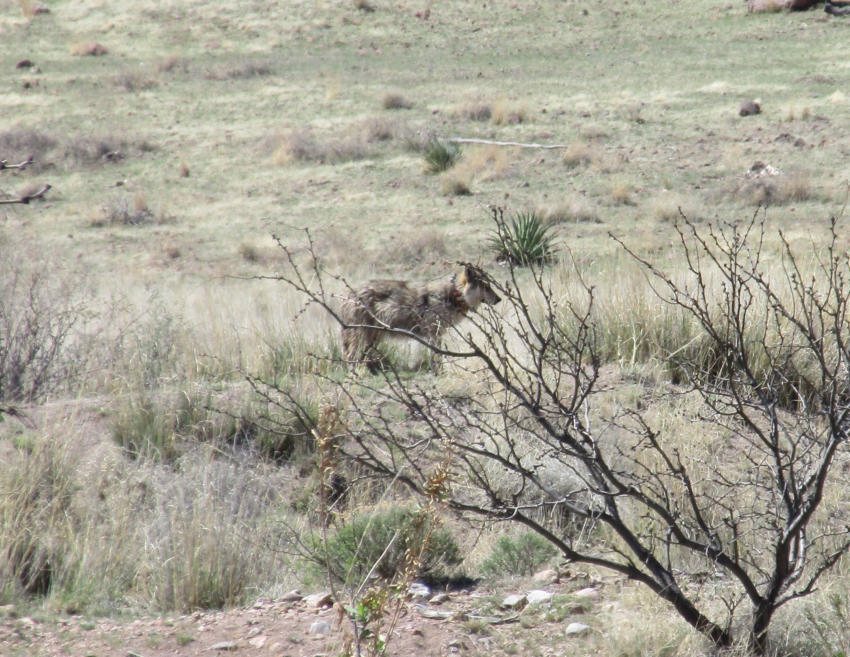31
Mar
In the News: Mexican wolf from reintroduction effort captured in Arizona

PHOENIX — A female Mexican wolf from an ongoing reintroduction effort in Mexico has been captured on private ranch land in southeastern Arizona.
U.S. Fish and Wildlife officials say the wolf captured Sunday has been relocated to the Sevilleta Wolf Management Facility in New Mexico, where it is in good health.
Management agencies in the U.S. and Mexico will determine the most appropriate long-term management action for the young wolf.
Authorities say the wolf was born last year at a captive wolf breeding facility in Cananea, Mexico, and released last October about 90 miles from the international border.
The last collar radio transmission was Feb. 14 from 21 miles south of the international border with New Mexico.
This article was published in the Las Cruces Sun-News
~~~~~~~~
Related Story:
Border-Crossing Gray Wolf Captured
Albuquerque Journal – March 31, 2017
The U.S. Fish and Wildlife Service says it has captured a Mexican gray wolf that was crisscrossing the U.S.-Mexico border.
Like the species reintroduction program managed by Fish and Wildlife in New Mexico and Arizona, Mexico has its own program to reintroduce Mexican wolves into the wild. The two countries have partnered closely for decades to bring the species back from near-extinction.
The captured female wolf, No. f1530, was born on a reserve in Sonora state last year, collared and released into the wild in Chihuahua state about 90 miles south of the border. Arizona Game and Fish spotted the wolf on ranch land in southeastern Arizona twice in late March.
“Wolves are wide-ranging,” said Craig Miller, senior Southwest representative of the nonprofit Defenders of Wildlife. “They course the landscape, especially this time of year. Maintaining that connectivity between core habitats in Mexico and the United States is essential to the long-term viability of the species.
“It’s really encouraging to know that captive-bred animals have retained the instincts necessary to survive in the wild,” he said.
But in Arizona, at one point, “the wolf exhibited minor problem behavior by not retreating after the reporting party tried to haze it out of the area,” Fish and Wildlife said in a news release.
Ranchers often report wolf sightings, particularly when they believe the animals may be stalking their livestock. Fish and Wildlife said it investigated several cattle depredations in the area and attributed one killing to wolf No. f1530.
The agency captured the wolf on March 26 and transferred it to the Sevilleta Wolf Management Facility in New Mexico, south of Socorro.
The wolf recovery area in New Mexico stretches from south of I-40 to the Mexican border.
There were 113 wolves in the wild in the U.S. at last count, including 50 in New Mexico, according to the Service, with most of the New Mexico population concentrated in the Gila National Forest.
The wolf was the second to have traveled north of the border from Mexico, Fish and Wildlife said, although in the previous instance the wolf stayed in southern New Mexico for four days before returning to the recovery area south of the border.
This article was published in the Albuquerque Journal
~~~~~~~~
Show your support for Mexican wolves with a Letter to the Editor today!
The letters to the editor page is one of the most widely read, influential parts of the newspaper. One letter from you can reach thousands of people and will also likely be read by decision-makers. Tips for writing your letter are below, but please write in your own words, from your own experience. Don’t try to include all the talking points in your letter.
Letter Writing Tips & Talking Points
“¢ This young wolf shows incredible strength in her successful journey across the international border. Her trek is a milestone to be celebrated.
“¢ As soon as the U.S. Fish and Wildlife Service releases this incredibly tough wolf back into the wild, she will bolster Mexican gray wolf recovery with her unique genetic makeup.
“¢ Science shows Mexican gray wolves need connected populations for recovery. This incident highlights the importance of an open international corridor connecting the two existing Mexican gray wolf populations. Any barrier that impedes movement between them threatens the success of recovery, including an extended border wall.
Make sure you:
“¢ Thank the paper for publishing the article
“¢ Submit your letter as soon as possible. The chance of your letter being published declines after a day or two since the article was published
“¢ Do not repeat any negative messages from the article, such as “so and so said that wolves kill too many cows, but”¦” Remember that those reading your letter will not be looking at the article it responds to, so this is an opportunity to get out positive messages about wolf recovery rather than to argue with the original article
“¢ Keep your letter brief, under 300 words
“¢ Include something about who you are and why you care: E.g. “I am a mother, outdoors person, teacher, business owner, scientific, religious, etc.”
“¢ Provide your name, address, phone number, and address. The paper won’t publish these, but they want to know you are who you say you are.
Submit your letter to the editor to the Las Cruce Sun-News and the Albuquerque Journal



